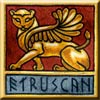
Lasa is an Etruscan fate Goddess who is closely associated with Turan, the Etruscan Goddess of love. Though She is very often depicted with Turan as if She were a minor attending Goddess, Lasa was important enough to merit Her own house on the famous bronze liver, used as a teaching tool by Etruscan haruspices, and depictions of Her or the Lasae are widespread. She is usually drawn as a beautiful winged Goddess, nude but for jewelry and boots. On one engraved mirror-back She is shown between Aivas and Hamphiare (Ajax and Amphiaraos in the Greek myth) holding a scroll on which is engraved all three of their names. To the Etruscans a scroll represented Fate and was depicted on funerary sculptures being held or read by the deceased, and inscribed with the life-deeds of the dead as a sort of reckoning to be judged in the Underworld (much like the modern myth of St. Peter checking his book at the entrance to the Christian Heaven). Lasa was frequently shown carrying an alabastron, a Greek type of perfume-vase, originally made of alabaster (hence the name) that had funerary connotations, and was either used to hold the perfume with which the dead were anointed, or left as an offering for the dead. Lasa is also a name given in the plural to a group of fate Goddesses, the Lasae, who form a loose group or sisterhood. They are generally depicted with wings and carry alabastrons like Lasa Herself. They may have been considered a type of personal guardian angel who watched over the individual in her or his lifetime, and guarded their graves after death. In the later Roman Hymn of the Arval Brethren (the company of twelve priests who made sacrifices for agricultural fertility for the good of the State), the Lasae are identified with the Lares Praestites ("the Lares/guardian spirits who fulfill [their duties]"), the guardian spirits of the Roman state, who are also known as the Lares Publici ("the Lares of the People"). The Lares have Etruscan origins and were probably originally the ghosts of the dead who had special ties to the land and who were an important part of both household and state worship, and the words Lasa and Lares may be related linguistically. Lasa and the Lasae do not look like especially foreboding Goddesses: it seems the fate aspect was balanced with a love aspect, or perhaps the Etruscan Underworld was not looked on with dread. For though the alabastron had funerary uses, it was also used by the living, especially women, to simply hold perfume, a use that accords nicely with Lasa's association with Turan the Love-Goddess. Another attribute shown with Lasa is the mirror, which may have a dual meaning too, as an indication of the appearance of beauty or as a mild punning reference to the dead, since the word for "reflection", hinthial, also could mean "ghost" in the Etruscan language. The wreath, another object often accompanying Lasa, could be used in both joyous festivities such as weddings or as a symbol of victory, or as an offering on a grave. Lasa was not infrequently shown all by Herself as a main subject, engraved on the back of a mirror or cast as the handle of a mirror or patera, suggesting She was not a mere handmaiden of Turan. Her numerous depictions indicate that She was quite a popular or well-known Goddess among the Etruscans. Lasa often appears with both Turan and Turan's lover Atuns (the Greek Adonis), the beautiful young hunter whom Turan adored, and who was fated to die young. Lasa's presence may indicate the large role Fate plays in the story of Atuns; the other Deities in attendance are Menrfa, Aplu (Apollo), and Amuke (the Greek King Amykos). Lasa could at other times be depicted hammering a nail into a wall, an act symbolic of ending or fixing events: at both the temples of Nortia, the Etruscan Goddess of Fate who was equated with the Roman Fortuna, and Minerva this rite was carried out on an annual basis to symbolize the year that had passed as well as the start of a new one. Lasa had quite a few epithets or variations: She could be called Lasa Recuneta ("The Approved" or "Excellent"), Lasa Vecu (associated with the Roman Vegoia, a prophetic nymph), Lasa Thimrae ("She Who Punishes"), or Lasa Sitmica ("She Who Fixes", perhaps in reference to the fixing or deciding of an individual's fate). Some Goddesses who were considered Lasae are: Evan, Mean, Achuvitr, and Alpan. She was equated with Fortuna Primigenia of the Romans, "Firstborn Fortune", one of their oldest forms of the fate Goddess. Another name for Lasa Herself, or a name for one of the Lasae is Rescunia ("She Who Causes Growth"). |
|
|



